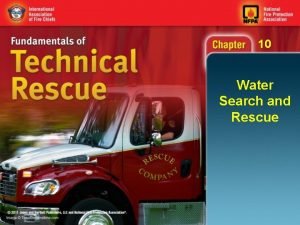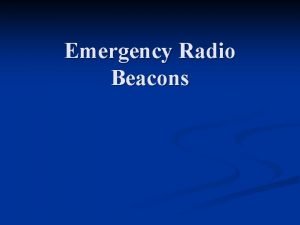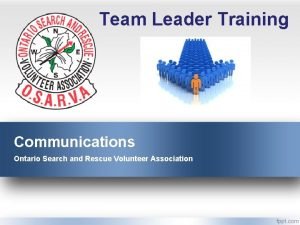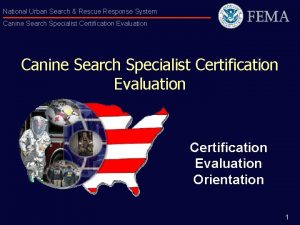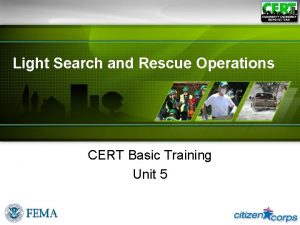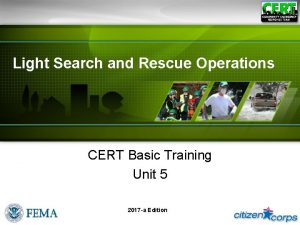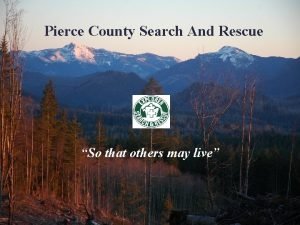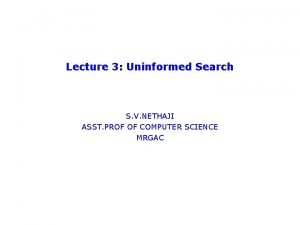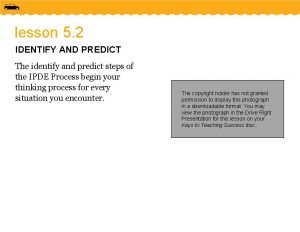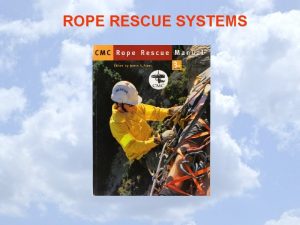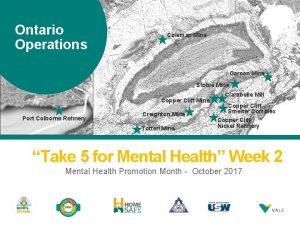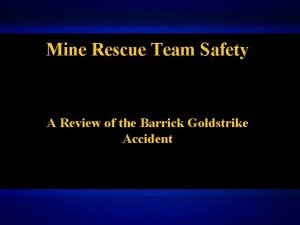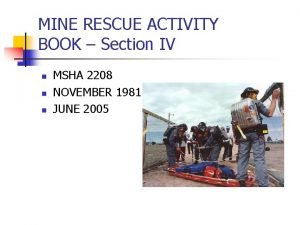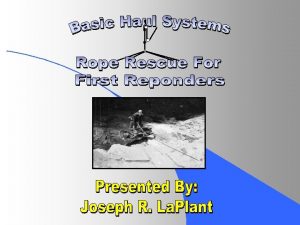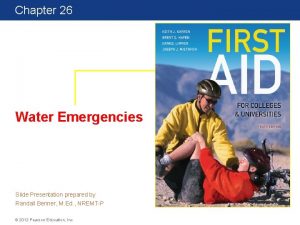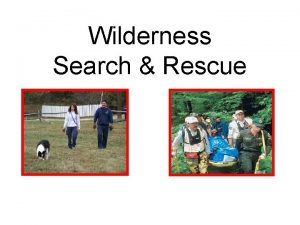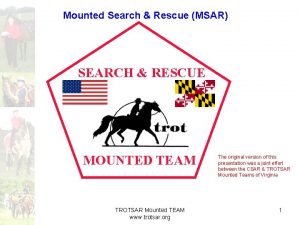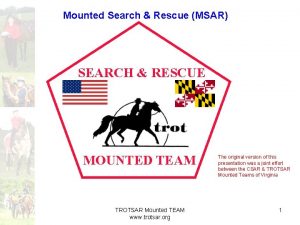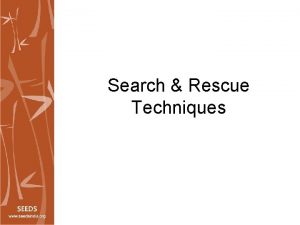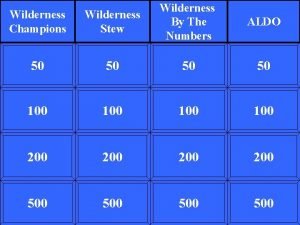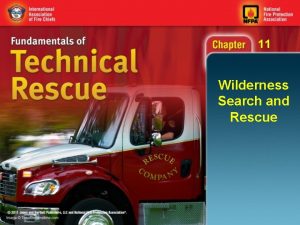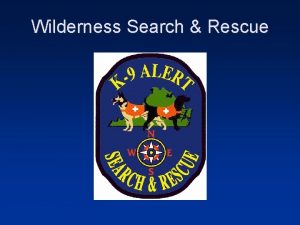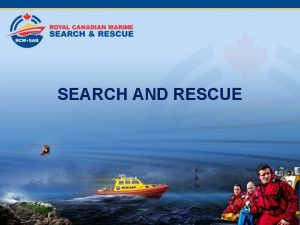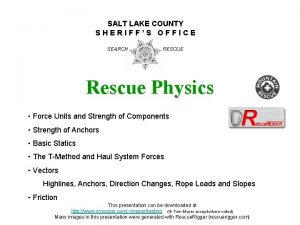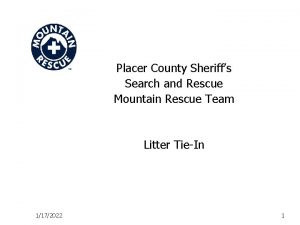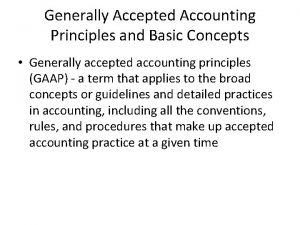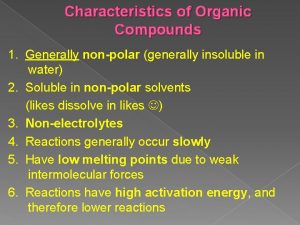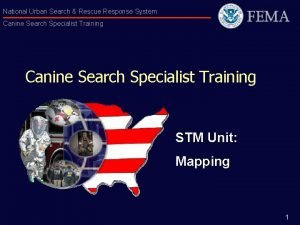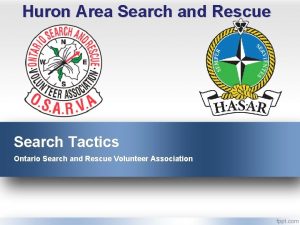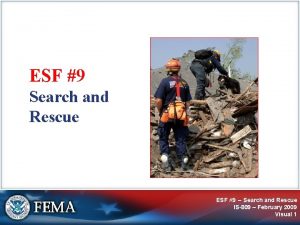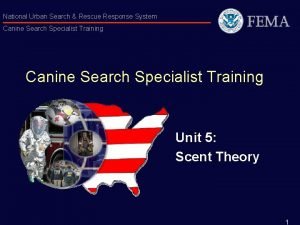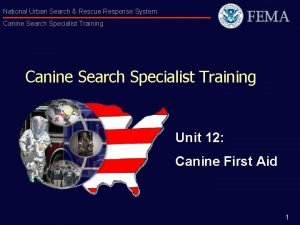Wilderness Search Rescue DEFINE WILDERNESS Wilderness is generally







































- Slides: 39

Wilderness Search & Rescue

DEFINE WILDERNESS • Wilderness is generally defined as a natural environment on Earth that has not been modified by human activity. • Will searches always take place in the wilderness?

DEFINE SAR Search And Rescue • The process of locating lost, missing, or overdue individuals and removing them from danger. • SAR is a service not a hobby

WILDERNESS SAR • National Search and Rescue Plan established in 1956 and updated in 1999 The National Search and Rescue plan designates the United States Coast Guard as the federal agency responsible for maritime SAR and the United States Air Force as the federal agency responsible for inland SAR. Most Wilderness Searches are handled by local agencies and do not require a national level response.

SAR RESPONSIBILITIES • US Coast Guard: Responsible for maritime search on waterways. • US Air Force: Responsible for inland SAR operations. • Department of Interior: Responsible for national parks. • Department of Agriculture: Responsible for US forest land. • Bureau of Land Management: Responsible for all other US owned land.

INDIANA DEPARTMENT OF HOMELAND SECURITY • The Indiana Department of Homeland Security operates Search and Rescue support functions. Resources from the State should be requested through your local Emergency Management Agency. -Training -Response -Support

INDIANA STATE SAR RESPONSIBILITIES • Indiana State Police • Department of Natural Resources.

SEARCH TRAINING LEVELS IS A 3 TIER SYSTEM • Awareness • Operations • Technician

INDIANA SAR PLAN • Title 10 of the Indiana Code makes reference to disaster SAR, only. • There is currently no plan for Civil SAR.

LOCAL SEARCH & RESCUE JURISDICTION • Indiana law changed July 2007 requiring that all missing persons, Adult and Child, Runaways and Abductions must have a immediate police response and an investigation conducted by the Law Enforcement Agency that it occurred in. Law Enforcement has overall responsibility of search for missing persons. IC-12 -10 -18 • Remember all missing, abduction and runaway scenes are considered crime scenes.

WHAT ARE YOU SEARCHING FOR • Elderly Walk-aways • Alzheimer's Patients • Despondent’s • Drug-Affected • Missing Children • Mentally Retarded • Lost Hikers • Disaster Related Search • Response to Criminal-Abduction and fugitive Incidents

WHAT YOU SHOULD NOT DO AS A FIRST RESPONDER • • Conduct interviews without Law Enforcement Conduct investigation Walk in potential crime scenes Law Enforcement is the best resource to obtain information and secure a scene.

RECOGNIZING THE NEED FOR SEARCH AND RESCUE • Upon your arrival it has been determined jointly by Fire and Police that information gathered indicates that a person is missing. If local trained assets are not on the scene a pre-determined response plan should be placed into action.

INITIATING SITE CONTROL AND SCENE MANAGEMENT • The Incident Command System (ICS) is the preferred method of on-scene incident management for all SAR operations. • All Search & Rescue operations will be managed by the concepts of the Incident Command System (ICS)/National Incident Management Systems (NIMS), with the responsible Law Enforcement Agency as the Command Agency.

INITIAL TASK OF FIRST IN COMPANIES – Establish ICS – Evaluate search urgency – Obtain lost person report – Determine type of response – Determine available resources – Determine probable search area

SITE CONTROL • • Non-Emergency Personnel Self Dispatched Agencies or Individuals Search Dogs Isolation of Family

CORE ELEMENTS – Locate the victim – Access the victim – Stabilize the victim – Transport the victim

SAR COMPONENTS – Pre-planning • Organization and management guidelines – Includes callout SOP’s & equipment – Local Teams (check with County EMA) – Notification • We have to be notified to handle it – Planning & Strategy • The process of gathering information so that an assessment can be done.

SAR COMPONENTS (con’t) – Tactics • Type of response • Solution to handle problem – Operations • Field phase where tactical solutions are carried out – Suspension • Discontinue operation – Post Incident Analysis • Evaluation of participants, methods and strategy

RESOURCES – – – – Search dogs Trackers Aircraft Ground / Air search specialist Rope Rescue Specialist Water Rescue Specialist Trench Rescue Specialist Collapse Rescue Specialist

TYPES OF SEARCH K-9’s • • • Air scent Trailing Cadaver / Human Remains Disaster Articles

CALCULATING SEARCH URGENCY – Factors (See Appendix) • Subject profile • Weather profile • Equipment profile • Subject experience profile • Terrain and hazards profile • History of incidents in this area • Bastard search

The lower the value of each factor and of the sum of all factors, the more urgent the situation.

BROAD TYPES OF RESPONSES • Depends on search urgency • Emergency response – Based on information – Convinced death, serious injury if no help – Blitz or hasty team – Minimum number of experienced rescuers sent to locate victims – Followed by support team – Additional equipment – Narrow margin of safety – Perceptible amount of risk

BROAD TYPES OF RESPONSES (con’t) – Measured response • Appropriate information on hand is insufficient to dictate exact outline of S & R action plan – Evaluative response • Occurs when reported problem is unconfirmed • Seems likely to resolve itself

ISOLATING WITNESSES OR REPORTING PARTIES • Lost person searches are very stressful events for everyone, but especially for the family and friends involved. Unfortunately, everyone who walks up to offer assistance wants to loiter around the family or the witnesses and ask questions. The family members then end up answering the same questions over and over.

ISOLATING WITNESSES OR REPORTING PARTIES • Move the witnesses or family members to areas where they will not be disturbed by bystanders and responders. • This provides the interviewer with the best setting to obtain information. • Buildings, Tents, or Response vehicles can be used.

LOST PERSON(S) REPORT (See Appendix) – Interview and obtain information from • Participants • Witnesses – Establish Strategic Objectives – Establish an Incident Action Plan – Each person lost receives a file • Part I - Information critical in determining decisions of the initiation phase of search • Part II – May be significant later in mission

RECOGNIZING GENERAL WILDERNESS HAZARDS – Personal • Blisters, scrapes, scratches, falls, blows, bruises, dehydration, etc. – Environmental hazards • Insect bites, stings, poisonous plants, exposure, snow-blindness, altitude illness, lightning, sunburn, animals

WILDERNESS HAZARDS (con’t) – Terrain • Cliffs, avalanches, standing / moving water, ice, caves, mines, wells, winds, snow, surf, etc. – Man-made hazards • Booby-trapped stills & drug labs, haz-mat dumps, attack dogs, etc.

ESTABLISHING PROBABLE SEARCH AREAS Methods Used – Theoretical Method • Using tables that express area as a function of distance traveled by the lost subject – Reliable point last seen (PLS) – Radius is maximum distance victim could have journeyed » In given terrain » In time elapsed since last seen

ESTABLISHING PROBABLE SEARCH AREAS Methods Used – Statistical Method • Based on data from case studies – Subjective Method • Historical data • Intuition • Location of natural barriers & clues • Consideration of physical & mental limitations

ESTABLISHING PROBABLE SEARCH AREAS Methods Used The Mattson Method. Balances subjective and objective information and uses individual personnel to view their probable search area independently, then combining their percentage of where he/she thinks they are to the rest of the group. The total percentage from all personnel involved is added and the greatest percent is where the search will be started.

SEARCH TACTICS – Type I (Detection phase) • Hasty teams – Type II • Open grid • Fast & efficient • Search of locales of high probability • Using methods to produce highest results / hour – Dogs – Planes – Open grid sweeps » 3 -7 searchers spaced 300 -600 ft. apart

SEARCH TACTICS (con’t) – Type III • Close grid – 30 searchers – Walk a line 15 -20 ft. apart – Maybe less for evidence recovery

SCENARIO • You are called for a 45 year male who has been missing since 2 am today's date. It is now 7 am and the family has called 911. • The family states he has no known medical problems. And knows the area well. He was seen by himself at 2 am. • The weather is 62 degrees and clear. His family says he was wearing a red wind breaker. The area he was last seen is rural and near the main river. There is currently a flood warning for the area. Weather 62 Deg and Clear Location Rural farm area. Search Assets No Local Assets


Wilderness SAR Summary • Recognize the need for wilderness search and rescue. • Identify the emergency response system of wilderness search and rescue incidents. • Identify site control and scene management procedures for wilderness search and rescue incidents. • Recognize the general hazards associated with wilderness search and rescue incidents. • Recognize the type of terrain involved in wilderness search and rescue incidents.

Wilderness SAR Summary • Recognize the limitations of conventional emergency response skills and equipment in various wilderness environments. • Identify the collection and recording information necessary to assist operational personnel in wilderness search and rescue. • Identify how to isolate any reporting parties or witnesses.
 Differentiate surf rescue to water swift rescue
Differentiate surf rescue to water swift rescue Search and rescue radar transponder
Search and rescue radar transponder Search and rescue aircraft signals
Search and rescue aircraft signals Ontario search and rescue volunteer association
Ontario search and rescue volunteer association Urban search and rescue markings
Urban search and rescue markings Search and rescue light
Search and rescue light Image search
Image search Pierce county search and rescue
Pierce county search and rescue Which search strategy is also called as blind search?
Which search strategy is also called as blind search? Federated discovery
Federated discovery Local search vs global search
Local search vs global search Federated search vs distributed search
Federated search vs distributed search Informed search and uninformed search in ai
Informed search and uninformed search in ai Https://images.search.yahoo.com
Https://images.search.yahoo.com Best first search in ai
Best first search in ai Blind search dan heuristic search
Blind search dan heuristic search Yahoo search video
Yahoo search video Yahoo search video
Yahoo search video Disadvantages of binary search tree
Disadvantages of binary search tree Search by image
Search by image Images.search.yahoo.com
Images.search.yahoo.com Cognitive search engine
Cognitive search engine Which search strategy is called as blind search
Which search strategy is called as blind search Http://search.yahoo.com/search?ei=utf-8
Http://search.yahoo.com/search?ei=utf-8 When predicting a point of conflict, you predict
When predicting a point of conflict, you predict Federated search connectors
Federated search connectors An orderly visual search pattern
An orderly visual search pattern Boulder food rescue
Boulder food rescue Shelbyfield animal rescue
Shelbyfield animal rescue Rope
Rope Rescue swimmer course
Rescue swimmer course Rescue deck
Rescue deck Mine rescue 18-6
Mine rescue 18-6 Mine rescue level 19-5
Mine rescue level 19-5 Mine rescue 7-19
Mine rescue 7-19 Mine rescue 13-17
Mine rescue 13-17 Hatchet chapter 10 questions and answers
Hatchet chapter 10 questions and answers If 3. hali
If 3. hali Rope rescue terminology
Rope rescue terminology Hip and shoulder support water rescue
Hip and shoulder support water rescue
